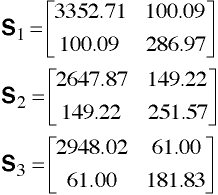
Univariate
Test of Equality of Population Variances
Using two sample variances from independent samples test:
H0: σ12 = σ22 versus H1: σ12 <> σ22

Note: Larger variance goes in the numerator.
With degrees of freedom ν1 = n1 -1 and ν2 = n2 - 1.
Multivariate
Test of Equality of Population Covariance Matrices
Hypotheses

Some Definitions

Let C be the pooled within covariance matrix.

Log-likelihood ratio Statistic

the product Mh is a chi-square with p(p+1)(k-1)/2 degrees of freedom.
When all the ni are equal h reduces to:

If the observed chi-square, Mh, is larger than the critical value then reject H0.
Example

Stata Matrix Program
scalar k = 3 scalar p = 2 scalar n1 = 33 scalar n2 = 37 scalar n3 = 24 matrix s1 = (3352.71, 100.09 \ 100.09, 286.97) matrix s2 = (2647.87, 149.22 \ 149.22, 251.57) matrix s3 = (2948.02, 61.00 \ 61.00, 181.83) matrix c1 = (1/(n1-1))*s1 matrix c2 = (1/(n2-1))*s2 matrix c3 = (1/(n3-1))*s3 matrix list c1 matrix list c2 matrix list c3 scalar n = n1+n2+n3 matrix c = (s1+s2+s3)/(n-k) matrix list c scalar d = det(c) scalar d1 = det(c1) scalar d2 = det(c2) scalar d3 = det(c3) scalar m = ((n-k)*log(d))-((n1-1)*log(d1) + (n2-1)*log(d2) + (n3-1)*log(d3)) display "m = " m scalar h=1-((2*p*p+3*p-1)/(6*(p+1)*(k-1))*(1/(n1-1)+1/(n2-1)+1/(n3-1)-1/(n-k))) display "h = " h scalar chi = m*h display "chi = " chi scalar df = p*(p+1)*(k-1)/2 display "df = " df display "prob = " chiprob(df, chi)
Multivariate Course Page
Phil Ender, 29Jan98